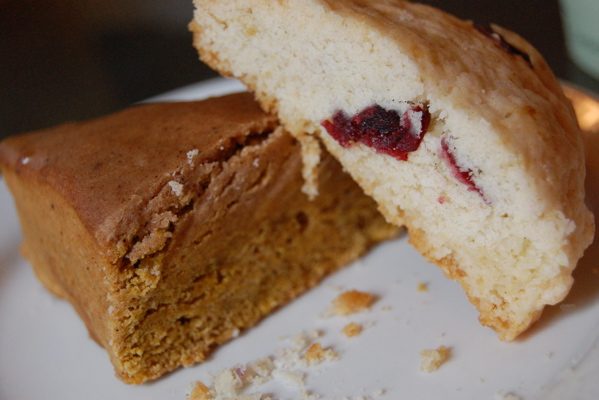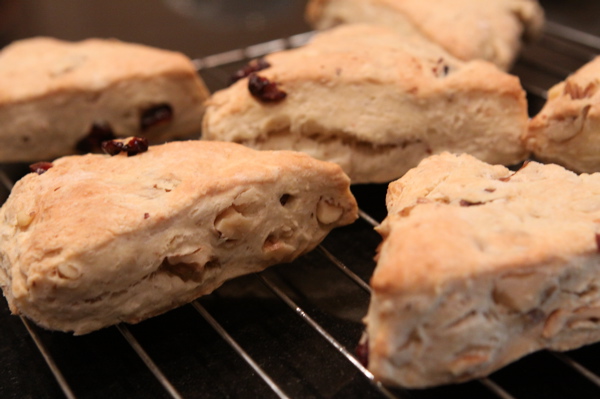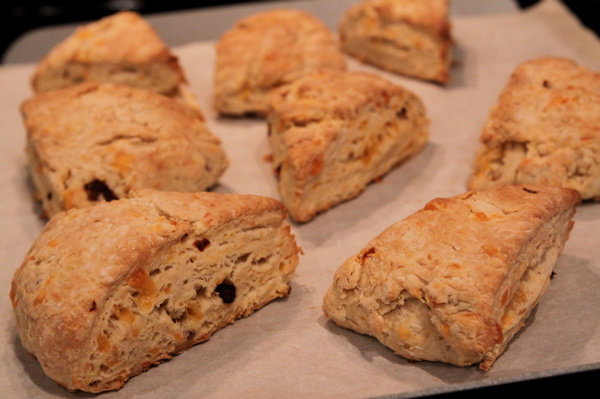
Delicate china teacups and stiff white linens typically pop into mind when thinking of scones – and for good reason. Although originating in Scotland, the traditional service of scones that we think of is for English afternoon tea, a light meal often consisting of sweet biscuits and scones topped with jam and clotted cream or lemon curd.
Second to these visions are the hockey puck-like scones that are too often offered up in coffee shops around the US. Tempting though they do look – dressed to the nines with white chocolate chunks, dried cranberries or other goodies – they are usually dry, tasteless, and, let’s face it, disappointing.
What is the deal with scones? Is there room in this moist-muffin and buttery-biscuit eating world for a scone?
I firmly believe there is.

To better understand the scone, let’s go back to England and their fluffy, yet dry versions served with tasty sides. A few technicalities to clear up…they say biscuit, we say cookie; they say scone, we say biscuit…wait…what? Yes, it’s true, scones are closely related to biscuits in that they contain much of the same ingredients – flour, baking powder, salt, fat (shortening or butter).
In fact, biscuits also originated as dry cakes before they arrived in America where we added some love (fat) and a leavening agent (baking powder or baking soda) to create what we now typically think of as a biscuit (visions of buttery, flaky melt in your mouth biscuits should be appearing).
So although the origins are much is the same and the ingredients are similar, let me tell you, eating a scone in a coffee shop in Anytown, USA is a far different experience than the swooning I do when eating a Southern home-style biscuit.

Why did the biscuit get all the love?
The best scones I have ever tasted were from Eli’s Coffee in my hometown of Morton, Illinois. Upon obtaining the recipe, the secret was immediately obvious…12 tablespoons of butter AND 1 cup of heavy cream, as opposed to the traditional scone recipe which typically calls for 3-4 tablespoons of butter and ½ to ¾ cup sour cream, half and half or milk (all of which have a much lower fat content than cream). These scones had been loved.
Bottom line: Somewhere along the way, we have confused our expectations by assuming that ordering a scone in the US will result in a soft, buttery experience and instead receiving a traditional, dry version served un-traditionally without its accompaniments.

Does this mean that there is no place in this world for a dry scone?
Absolutely not. To eat a scone is to savor every last crumb, a delightful pleasure that will not cause regret. But the key to this scone satisfaction is to bake and serve them appropriately, in one of the following ways:
1. Traditional – baked with less fat and served as a bread-like holder for goodies like jam and clotted cream. For a proper experience, try the tea service at the St. Paul Hotel. At home, try this recipe for traditional English tea time scones with jam and cream.
2. American – like a muffin/biscuit hybrid with higher fat content (more butter and cream, please) and without accompaniments. For scrumptious stand-alone scones in the Twin Cities, try them from Butter Bakery in South Minneapolis. As the name promises, their scones are made with plenty of butter and they are worth it.
3. Savory – another American version of the traditional scone with additions such as cheese, bacon and herbs. While these tend to be a bit drier, they satisfy as a side for a dish like soup. Try these smokey chipotle cheddar scones alongside a spicy black bean soup.
However you choose to enjoy scones – traditional, American or savory – remember to do so without regrets.

As a fan of full flavor (which usually means full fat ingredients) I agree with Katie Cannon and I appreciate this article as the best treats are usually worth the fat!
I never knew about the scone/biscuit evolution. Very interesting article. I’d say the best American scones around town are to be had at Fireroast Mountain Cafe in in Longfellow. (http://www.fireroastmountaincafe.com/) Even with the oats involved, they are perfectly baked to crumble but not be dried out seeming. They also make some excellent flavor combos–I had an amazing cardamom pistachio one recently.
Other scone thoughts…if you care to read on:
If you ever lived in Ireland and miss the delicious currant scones there, Kopplin’s (http://www.kopplinscoffee.com/) in St. Paul serves perfect currant scones (round and everything) from Rustica (http://www.rusticabakery.com) (bring your own butter, though) and the absolute best coffee in town.
If I’m having friends over for breakfast, I love the recipe from my 1967 Joy of Cooking. I’m not sure if it’s American or traditional, but it has some butter, and that butter better be Hope!
Thanks for the comments and I’m glad you enjoyed the article! I have actually had the Fireroast Mountain Cafe scones – I’m glad you brought them up. They are tasty! I’ll definitely have to stop by Kopplin’s (butter in tow), too!
The best scones ever to be produced in the Twin Cities were made by Frances Swanson at Francesca’s Cafe on West 7th in St. Paul. Light, flavorful and made from real butter, real fresh flour, everything good and wholesome. She combined the ingredients by hand rather than use an industrial mixer and it made all the difference. The place closed a number of years ago, and I have never gotten over it. Last I heard she was selling real estate. Maybe in this market she’ll come back to food? Everybody still has to eat…..
I agree, it is hard to find a good scone in this town. However, that is because the scones at Rustica sell out pretty quickly. If I can obtain a Buttermilk Scone from Rustica, it is a day touched by heaven. Seriously, the best scones. Try one.
Clarification:
Only one variety of scone at Rustica contains buttermilk (Maple Oat scone).
The remainder are cream based scones.
Thanks for your appreciation.
– Tammy Hoyt.
Head Baker @ Rustica